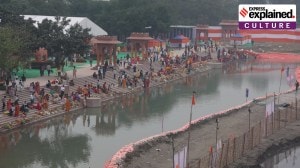Desert roads lead to discovery in Egypt
Explorations of the Theban Desert Road Survey have uncovered extensive remains of a 3,500-year-old settlement,which researchers say could rewrite the history of a little-known period in Egypts past and the role played by desert oases
Over the last two decades,John Coleman Darnell and his wife,Deborah,hiked and drove caravan tracks west of the Nile from the monuments of Thebes,at present-day Luxor. These and other desolate roads,beaten hard by millennial human and donkey traffic,only seemed to lead to nowhere.
In the practice of what they call desert-road archaeology,the Darnells found pottery and ruins where soldiers,merchants and other travellers camped in the time of the pharaohs. On a limestone cliff at a crossroads,they came upon a tableau of scenes and symbols,some of the earliest documentation of Egyptian history. Elsewhere,they discovered inscriptions considered to be one of the first examples of alphabetic writing.
The explorations of the Theban Desert Road Survey,a Yale University project co-directed by the Darnells,called attention to the previously underappreciated significance of caravan routes and oasis settlements in Egyptian antiquity. And two weeks ago,the Egyptian government announced what may be the surveys most spectacular find.
Zahi Hawass,secretary general of the Supreme Council of Antiquities,said the archaeologists had uncovered extensive remains of a settlementapparently an administrative,economic and military centrethat flourished more than 3,500 years ago in the western desert 110 miles west of Luxor and 300 miles south of Cairo. No such urban centre so early in history had ever been found in the forbidding desert.
Dr John Darnell,a professor of Egyptology at Yale,said in an interview that the discovery could rewrite the history of a little-known period in Egypts past and the role played by desert oases,those islands of springs and palms and fertility,in the civilisations revival from a dark crisis. Other archaeologists not involved in the research said the findings were impressive and,once a more detailed formal report is published,will be sure to stir scholars stew pots.
The 218-acre site is at Kharga Oasis,a string of well-watered areas in a 60-mile-long north-south depression in the limestone plateau that spreads across the desert. The oasis is at the terminus of the ancient Girga Road from Thebes and its intersection with other roads from the north and the south.
A decade ago,the Darnells spotted hints of an outpost from the time of Persian rule in the sixth century B.C. at the oasis in the vicinity of a temple. A temple wouldnt be where it was if this area hadnt been of some strategic importance, Deborah Darnell,also trained in Egyptology,said in an interview.
Then she began picking up pieces of pottery predating the temple. Some ceramics were imports from the Nile Valley or as far away as Nubia,south of Egypt,but many were local products. Evidence of really large-scale ceramic production, she noted,is something you wouldnt find unless there was a settlement here with a permanent population,not just seasonal and temporary.
It was in 2005 that the Darnells and their team began collecting the evidence that they were on to an important discovery: remains of mud-brick walls,grindstones,baking ovens and heaps of fire ash and broken bread moulds. Describing the half-tonne of bakery artifacts that has been collected,as well as signs of a military garrison,Darnell said the settlement was baking enough bread to feed an army,literally. This inspired the name for the site,Umm Mawagir. The Arabic phrase means mother of bread moulds.
In addition,Darnell said,the team found traces of what is probably an administrative building,grain silos,storerooms and artisan workshops and the foundations of many unidentified structures. The inhabitants,probably a few thousand people,presumably grew their own grain,and the variety of pottery attested to trade relations over a wide region. Umm Mawagirs heyday apparently extended from 1650 B.C. to 1550 B.C.,nearly a thousand years after the construction of the Great Pyramid at Giza and another thousand before any previously known major occupation at Kharga Oasis.
Finding an apparently robust community as a hub of major caravan routes,Darnell said,should help us reconstruct a more elaborate and detailed picture of Egypt during an intermediate period after the so-called Middle Kingdom and just before the rise of the New Kingdom.



- 01
- 02
- 03
- 04
- 05




























